Economic Productivity vs. Ecological Protection in Danube Floodplain. Case Study: Danube’s Sector between Olt and Vedea
Abstract
1. Introduction
- O1—Identifying possible models for the future restoration of the Danube floodplain;
- O2—Evaluating the perception of stakeholders involved in the current and future use of the plots from the Danube floodplain, as a key factor for translating the principles of sustainable development into a future ecologic restoration of the area.
2. Study Area
3. Materials and Methods
4. Results
4.1. Identifying Possible Models for the Future Restoration of the Danube Floodplain
“In the years of high floods …. The entire Danube floodplain becomes a sea in the true sense of the word with powerful waves … a fish farm develops on its flooded meadows”.[53] (p. 2)
“If the natural and economic conditions allowed for it, some parts would be valued through agriculture, some through fishing, others would be left as meadows or would be forested, and others will become built-up/industrial areas, etc.”.[53] (p.7)
4.2. Evaluating Stakeholders’ Opinions on the Current and Future Use of the Analysed Sector of the Danube Floodplain
“Conversely, if we would not receive the APIA subsidy, we would surely sell our arable lands because of high production costs; nothing would motivate us to keep them”.(interview extract, landowner of a small farm, male, 62 years old, from Ciuperceni)
“We agree with a partial ecological restoration, but it has to be integrated for everybody living in the Danube floodplain, we have to support the small farmers but also the agricultural holdings because the latter are the biggest source of taxes for the local budgets”.(interview extract, local councillor, man, 58 years, Suhaia)
“We want that agriculture remains the main activity in the Danube floodplain because we do not justify abandoning the infrastructure network built through enormous financial efforts by the state”.(interview extract, agricultural expert, man, 56 years old)
“We would like to reconcile the economic role with the ecologic one in the Danube floodplain; we do not exclude production activities, but at the same time we support environmental protection and conservation”.(interview extract, environmental conservation and protection expert, man, 43 years old)
5. Discussion
- The farmers, further split into two distinctive groups: Landowners of small farms, more numerous but less important as economic and decisional power; and owners or representatives of agricultural holdings. The latter group is by far the most influential on the final usage of the land they own or lease, being the most affected by the land use and environmental changes in the region. Dynamic and highly interested in the economic effects of the ecological restoration, this group is the most influential in relation to the other groups in their attempt to determine the orientation of the development policies in the area.
- The public authorities at the local level represent another key stakeholder we approached. In charge of formulating policy agendas and objectives, spreading public information, but also with addressing and mediating conflicts, they are supposed to “support a decision-making process that is based on the value of consensus”, even if in practice the political affiliations and economic considerations influence the decision-making process [60]. Consequently, they are a group displaying both a considerable power and interest in the ecological restoration of the Danube floodplain.
- The NGO’s represent an important voice sometimes influencing the political factor in the design of environmental policies and displaying a high interest in the ecological restoration
- Two distinctive groups of experts interested to different extents in a full or partial ecological restoration of the studied area, as they represent ecologists (experts in the environmental domain) or economists (experts in the productive domain, mainly agronomist engineers), are key stakeholder groups placed at the bottom of the power scale. They display a high and a very high interest but a low operational capacity (power) to influence and determine the change of the current land use in the area.
6. Conclusions
Author Contributions
Funding
Acknowledgments
Conflicts of Interest
References
- Solomon, S.; Qin, D.; Manning, M.; Averyt, K.; Marquis, M.; Tignor, M.M. Climate Change 2007—The Physical Science Basis: Working Group I Contribution to the Fourth Assessment Report of the IPCC; Cambridge University Press: Cambridge, UK, 2007; Volume 4. [Google Scholar]
- Guo, B.; Xie, T.; Subrahmanyam, M. The Impact of China’s Grain for Green Program on Rural Economy and Precipitation: A Case Study of Yan River Basin in the Loess Plateau. Sustainability 2019, 11, 5336. [Google Scholar] [CrossRef]
- Hilderbrand, R.H.; Watts, A.C.; Randle, A.M. The myths of restoration ecology. Ecol. Soc. 2005, 10, 19. [Google Scholar] [CrossRef]
- Egan, D.; Hjerpe, E.E.; Abrams, J.; Higgs, E. Human Dimensions of Ecological Restoration: Integrating Science, Nature, and Culture; Island Press: Washington, DC, USA, 2012. [Google Scholar]
- Hulea, O.; Ebert, S.; Strobel, D. Floodplain restoration along the Lower Danube: A climate change adaptation case study. IOP Conf. Ser. Earth Environ. Sci. 2009, 6, 402002. [Google Scholar] [CrossRef]
- Munich, R. Annual Review: Natural Catastrophes 2004; Knowledge Series; Münchener Rück: München, Germany, 2005. [Google Scholar]
- Dankers, R.; Christensen, O.B.; Feyen, L.; Kalas, M.; de Roo, A. Evaluation of very high-resolution climate model data for simulating flood hazards in the Upper Danube Basin. J. Hydrol. 2007, 347, 319–331. [Google Scholar] [CrossRef]
- Kundzewicz, Z.W.; Ulbrich, U.; Graczyk, D.; Krüger, A.; Leckebusch, G.C.; Menzel, L.; Pińskwar, I.; Radziejewski, M.; Szwed, M. Summer floods in Central Europe–climate change track? Nat. Hazards 2005, 36, 165–189. [Google Scholar] [CrossRef]
- Galat, D.L.; Fredrickson, L.H.; Humburg, D.D.; Bataille, K.J.; Bodie, J.R.; Dohrenwend, J.; Gelwicks, G.T.; Havel, J.E.; Helmers, D.L.; Hooker, J.B.; et al. Flooding to Restore Connectivity of Regulated, Large-River Wetlands: Natural and controlled flooding as complementary processes along the lower Missouri River. BioScience 1998, 48, 721–733. [Google Scholar] [CrossRef]
- Sparks, R.; Braden, J.; Demissie, M.; Mitra, P.; Schneider, D.; White, D.; Xia, R. Technical Support of Public Decisions to Restore Floodplain Ecosystems: A Status Report on the Illinois River Project, USA; Backhuys Publishers: Leiden, The Netherlands, 2000; pp. 225–247. [Google Scholar]
- Ahn, C.; Johnston, D.M.; Sparks, R.E.; White, D.C. Analysis of naturalization alternatives for the recovery of moist-soil plants in the floodplain of the Illinois River. In Living Rivers: Trends and Challenges in Science and Management; Leuven, R.S.E.W., Ragas, A.M.J., Smits, A.J.M., van der Velde, G., Eds.; Springer: Dordrecht, The Netherlands, 2006; pp. 217–228. [Google Scholar]
- Sparks, R.E. Need for Ecosystem Management of Large Rivers and Their Floodplains. BioScience 1995, 45, 168–182. [Google Scholar] [CrossRef]
- Sparks, R.E.; Braden, J.B. Naturalization of Developed Floodplains: An Integrated Analysis. J. Contemp. Water Res. Educ. 2007, 136, 7–16. [Google Scholar] [CrossRef]
- Sparks, R.E.; Nelson, J.C.; Yin, Y. Naturalization of the Flood Regime in Regulated Rivers: The case of the upper Mississippi River. BioScience 1998, 48, 706–720. [Google Scholar] [CrossRef]
- Declaration on the Cooperation for the Creation of a Lower Danube Green Corridor. 2000. Available online: http://awsassets.panda.org/downloads/ldgcdeclaration.pdf (accessed on 5 May 2019).
- Danube Delta National Institute for Research and Development. The Ecological and Economic Resizing Programme in Romanian Sector of the Danube Floodplain; Contract No. 3683/M.M.D.D./2006; Danube Delta National Institute for Research and Development: Bucharest, Romania, 2008. [Google Scholar]
- Nichersu, I. Flood risk management, ecological and economical resizing in Danube Floodplain and Danube Delta spatial planning. In Proceedings of the Danube Environment Forum, Tulcea, Romania, 27–29 June 2013. [Google Scholar]
- Stoiculescu, C.D. Reconstrucţia Ecologică a Zonei Inundabile a Dunării Româneşti; SC Green Steps SRL: Bucharest, Romania, 2008. [Google Scholar]
- Monitorul Oficial al României. Government Decision No. 2151/ 30.11.2004 on the Establishment of Protected Natural Area Regime for New Regions; Monitorul Oficial al României: Bucharest, Romania, 2005. [Google Scholar]
- Monitorul Oficial al României. Government Decision No. 1284/ 24.10.2007 on Establishing Special Avifaunistic Protection Areas as Integral Part of the European Ecological Network Natura 2000; Monitorul Oficial al României: Bucharest, Romania, 2007. [Google Scholar]
- Ramsar Convention. Romania. 2019. Available online: https://www.ramsar.org/countries/romania?page=3 (accessed on 10 June 2019).
- Danube Floodrisk Final Report. 2012. Available online: http://www.oerok-projektdatenbank.at/upload/206_Danube%20Floodrisk%20Final%20Report.pdf (accessed on 29 September 2019).
- Rădulescu, D.; Chendeș, V.; Ion, M.B. Realizarea hărţilor de hazard şi risc pe teritoriul României, conform cerinţelor Directivei 2007/60/CE. Rev. Asoc. Române Ştiinţe Hidrol. 2014, 9, 19–23. [Google Scholar]
- Posner, C. Analiza Strategiilor de Adaptare la Inundații ale Comunităților Locale Prin Folosirea Metodelor Tradiționale și Participative de Cercetare. Studiu de Caz: Valea Dunării Între Giurgiu și Gostinu. Ph.D. Thesis, University of Bucharest, București, Romanian, 2015. [Google Scholar]
- Hein, T.; Schwarz, U.; Habersack, H.; Nichersu, I.; Preiner, S.; Willby, N.; Weigelhofer, G. Current status and restoration options for floodplains along the Danube River. Sci. Total Environ. 2016, 543, 778–790. [Google Scholar] [CrossRef] [PubMed]
- Funk, A.; Martínez-López, J.; Borgwardt, F.; Trauner, D.; Bagstad, K.J.; Balbi, S.; Magrach, A.; Villa, F.; Hein, T. Identification of conservation and restoration priority areas in the Danube River based on the multi-functionality of river-floodplain systems. Sci. Total Environ. 2019, 654, 763–777. [Google Scholar] [CrossRef] [PubMed]
- The National Strategy for Sustainable Development—Romania 2030. Available online: https://www.edu.ro/sites/default/files/Strategia-nationala-pentru-dezvoltarea-durabila-a-Rom%C3%A2niei-2030.pdf (accessed on 16 June 2019).
- European Parliament; Council of Europe. Directive 2000/60/EC of the European Parliament and of the Council Establishing a Framework for Community Action in the Field of Water Policy; European Parliament: Belgium, Brussels; Council of Europe: Strasbourg, France, 2000. [Google Scholar]
- European Parliament; Council of Europe. Directive 2007/60/EC of the European Parliament and of the Council of 23 October 2007 on the Assessment and Management of Flood Risks; European Parliament: Belgium, Brussels; Council of Europe: Strasbourg, France, 2007. [Google Scholar]
- Gren, M.; Groth, K.-H.; Sylvén, M. Economic values of Danube floodplains. J. Environ. Manag. 1995, 45, 333–345. [Google Scholar] [CrossRef]
- Dorondel, Ș.; Armaș, I.; Florian, V.; Rusu, M.; Posner, C.; Șerban, S. Ghid de Bune Practici Privind Transformările Socio-Economice și de Mediu Din Lunca Dunării; Francisc I. Rainer Institute of Anthropology: București, Romania, 2016; Available online: https://www.researchgate.net/publication/308746883_GHID_DE_BUNE_PRACTICI_PRIVIND_TRANSFORMARILE_SOCIO-ECONOMICE_SI_DE_MEDIU_DIN_LUNCA_DUNARII (accessed on 7 November 2019).
- Ivan, O. Trăind cu apele. Cum se adaptează o comunitate la încă o reconfigurare a peisajului din Lunca Dunării. Natl. Geogr. 2015, 12, 104–113. [Google Scholar]
- Buijs, A.E. Public support for river restoration. A mixed-method study into local residents’ support for and framing of river management and ecological restoration in the Dutch floodplains. J. Environ. Manag. 2009, 90, 2680–2689. [Google Scholar] [CrossRef]
- Neuman, W.L.; Robson, K. Basics of Social Research: Qualitative and Quantitative Approaches; Pearson: Boston, MA, USA, 2007; p. 48. [Google Scholar]
- Berg, B.L. Qualitative Research Methods for the Social Sciences, 7th ed.; Allyn&Bacon: Boston, MA, USA, 2009. [Google Scholar]
- Crossman, A. Conducting Case Study Research in Sociology 2019. Available online: https://www.thoughtco.com/case-study-definition-3026125 (accessed on 10 July 2019).
- Syme, W.; Pinnell, M.; Wicks, J. Modelling flood inundation of urban areas in the UK using 2D/1D hydraulic models. In Proceedings of the 8th National Conference on Hydraulics in Water Engineering, Paradise, QLD, Australia, 13–16 July 2004; The Institution of Engineers: Barton, ACT, Australia, 2004. [Google Scholar]
- Rood, S.B.; Samuelson, G.M.; Braatne, J.H.; Gourley, C.R.; Hughes, F.M.; Mahoney, J.M. Managing river flows to restore floodplain forests. Front. Ecol. Environ. 2005, 3, 193–201. [Google Scholar] [CrossRef]
- Lamouroux, N.; Gore, J.A.; Lepori, F.; Statzner, B. The ecological restoration of large rivers needs science-based, predictive tools meeting public expectations: An overview of the Rhône project. Freshw. Biol. 2015, 60, 1069–1084. [Google Scholar] [CrossRef]
- Lin, B.; Wicks, J.M.; Falconer, R.A.; Adams, K. Integrating 1D and 2D hydrodynamic models for flood simulation. In Proceedings the Institution of Civil Engineers-Water Management; ICE Virtual Library: London, UK, 2006; pp. 19–25. [Google Scholar]
- Wallingford, H. ISIS Flow User Manual; HR Wallingford: Wallingford, UK, 1997. [Google Scholar]
- Crooks, S.; Naden, P. CLASSIC: A semi-distributed rainfall-runoff modelling system. Hydrol. Earth Syst. Sci. Discuss. 2007, 11, 516–531. [Google Scholar] [CrossRef]
- Bradbrook, K. JFLOW: A multiscale two-dimensional dynamic flood model. Water Environ. J. 2006, 20, 79–86. [Google Scholar] [CrossRef]
- European Environment Agency. Corine Land Cover Accounting Layers. Available online: https://www.eea.europa.eu/data-and-maps/data/corine-land-cover-accounting-layers (accessed on 29 June 2019).
- Google Earth Pro V7.3.3.5776. Suhaia Lake, Romania 43°42’94” N, 25°12’08” E, Eye alt 446 km. 2019. Available online: https://www.google.com/intl/ro/earth/ (accessed on 1 July 2019).
- The Geo-Spatial Cartographic Database. Available online: http://geo-spatial.org/ (accessed on 20 June 2019).
- Lozato-Giotart, J.-P. Géographie du Tourisme: De L’espace Consommé à L’espace Maîtrisé; Pearson Education: Montreuil, France, 2003. [Google Scholar]
- Popovici, E.; Bălteanu, D.; Kucsicsa, G. Utilizarea terenurilor și dezvoltarea actuală a agriculturii. In România. Natură şi Societate; Editura Academiei Române: Bucharest, Romania, 2016; pp. 329–374. [Google Scholar]
- Tudor, C.A.; Iojă, I.C.; Rozylowicz, L.; Pǎtru-Stupariu, I.; Hersperger, A.M. Similarities and differences in the assessment of land-use associations by local people and experts. Land Use Policy 2015, 49, 341–351. [Google Scholar] [CrossRef]
- Stylidis, D.; Biran, A.; Sit, J.; Szivas, E.M. Residents’ support for tourism development: The role of residents’ place image and perceived tourism impacts. Tour. Manag. 2014, 45, 260–274. [Google Scholar] [CrossRef]
- Vinke-de Kruijf, J. The Role of Dutch Expertise in Romanian Water Projects: Case Study ”Room for the River in Cat’s Bend, Romania”; University of Twente: Enchede, The Netherlands, 2011. [Google Scholar]
- Warner, J.F.; van Buuren, A.; Edelenbos, J. Making Space for the River; IWA Publishing: London, UK, 2012. [Google Scholar]
- Antipa, G. Regiunea Inundabilă a Dunării. Starea ei Actuală și Mijloacele de a o Pune în Valoare; Institutul de Arte Grafice Carol Gobl: Bucharest, Romania, 1910. [Google Scholar]
- Vijulie, I.; Manea, G.; Tîrlă, L.; Matei, E.; Preda, M.; Cuculici, R. Revival of the Rice Crops in the South of Romania: Pros and Cons. Procedia Environ. Sci. 2016, 32, 373–385. [Google Scholar] [CrossRef][Green Version]
- Monitorul Oficial al României. Land Fund Law No.18; no 37/20.02.1991; Monitorul Oficial al României: Bucharest, Romania, 1991. [Google Scholar]
- Buckley, M.C.; Crone, E.E. Negative Off-Site Impacts of Ecological Restoration: Understanding and Addressing the Conflict. Conserv. Biol. 2008, 22, 1118–1124. [Google Scholar] [CrossRef] [PubMed]
- Tockner, K.; Stanford, J.A. Riverine flood plains: Present state and future trends. Environ. Conserv. 2002, 29, 308–330. [Google Scholar] [CrossRef]
- Grimble, R.; Wellard, K. Stakeholder methodologies in natural resource management: A review of principles, contexts, experiences and opportunities. Agric. Syst. 1997, 55, 173–193. [Google Scholar] [CrossRef]
- Mendelow, A.L. Environmental Scanning-The Impact of the Stakeholder Concept. In Proceedings of the International Conference on Information Systems - ICIS, Cambridge, MA, USA, 7 December 1981; p. 20. Available online: https://aisel.aisnet.org/icis1981/20 (accessed on 7 November 2019).
- McGinnis, M.V.; Woolley, J.; Gamman, J. Bioregional conflict resolution: Rebuilding community in watershed planning and organizing. Environ. Manag. 1999, 24, 1–12. [Google Scholar] [CrossRef] [PubMed]
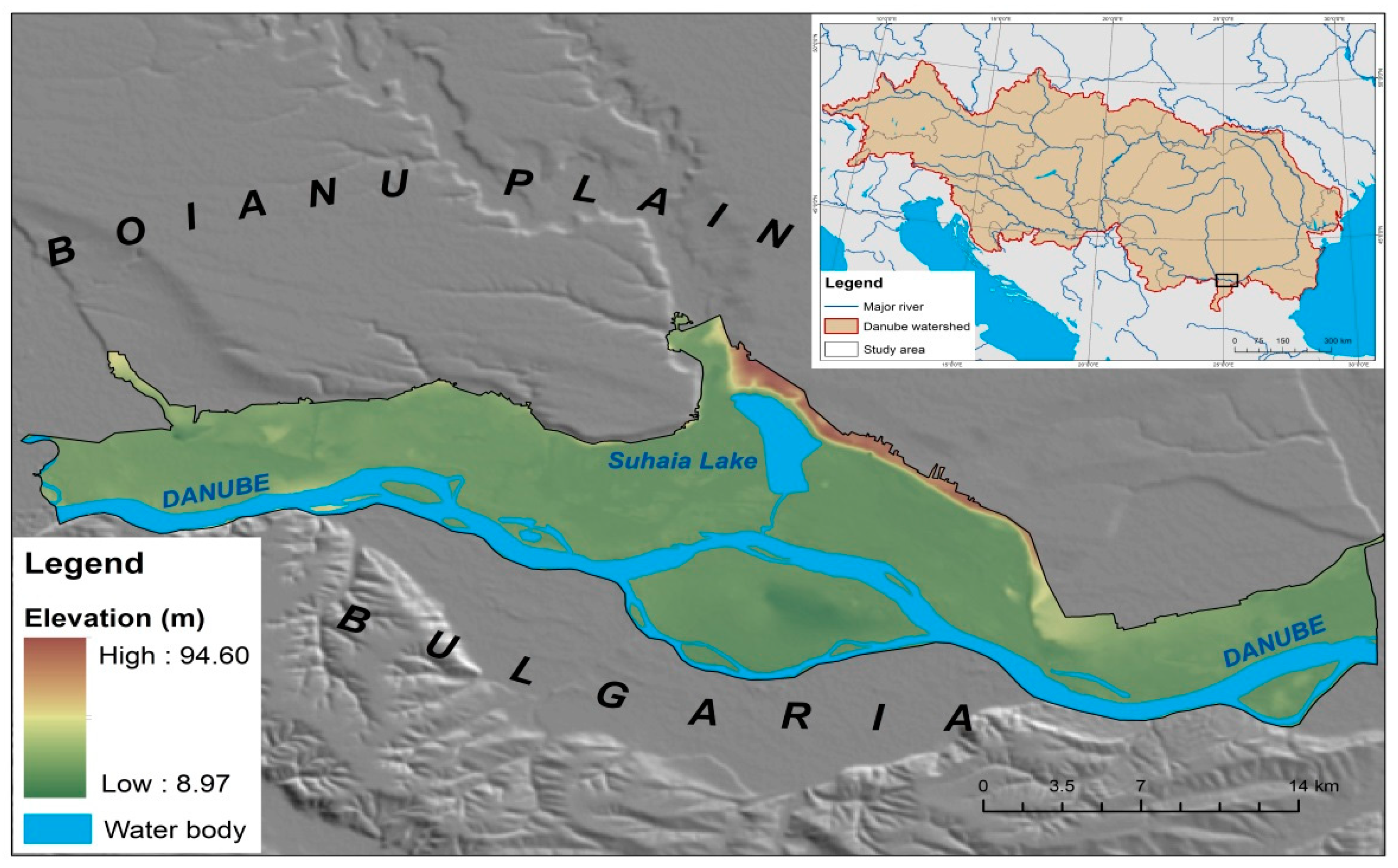
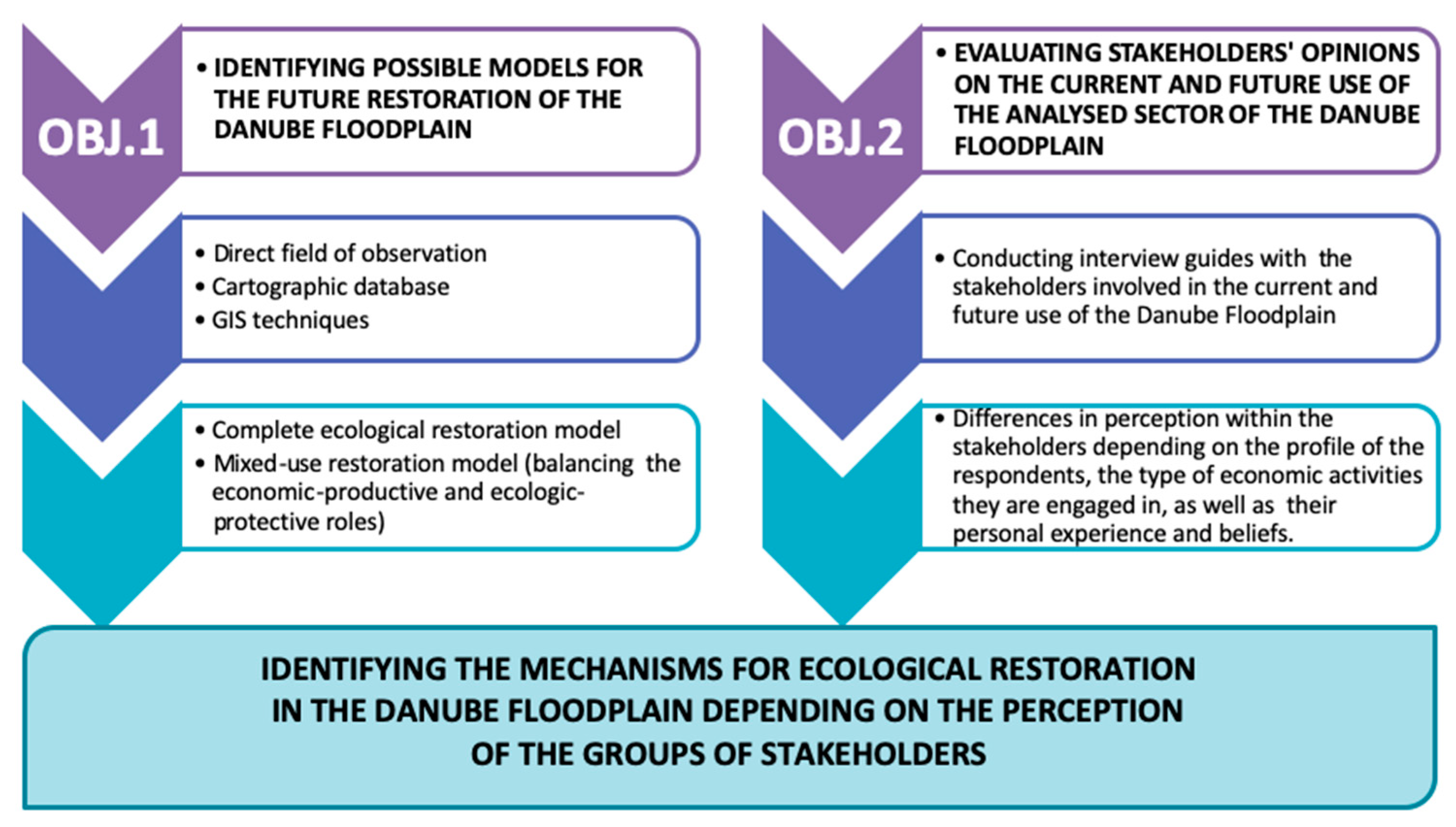
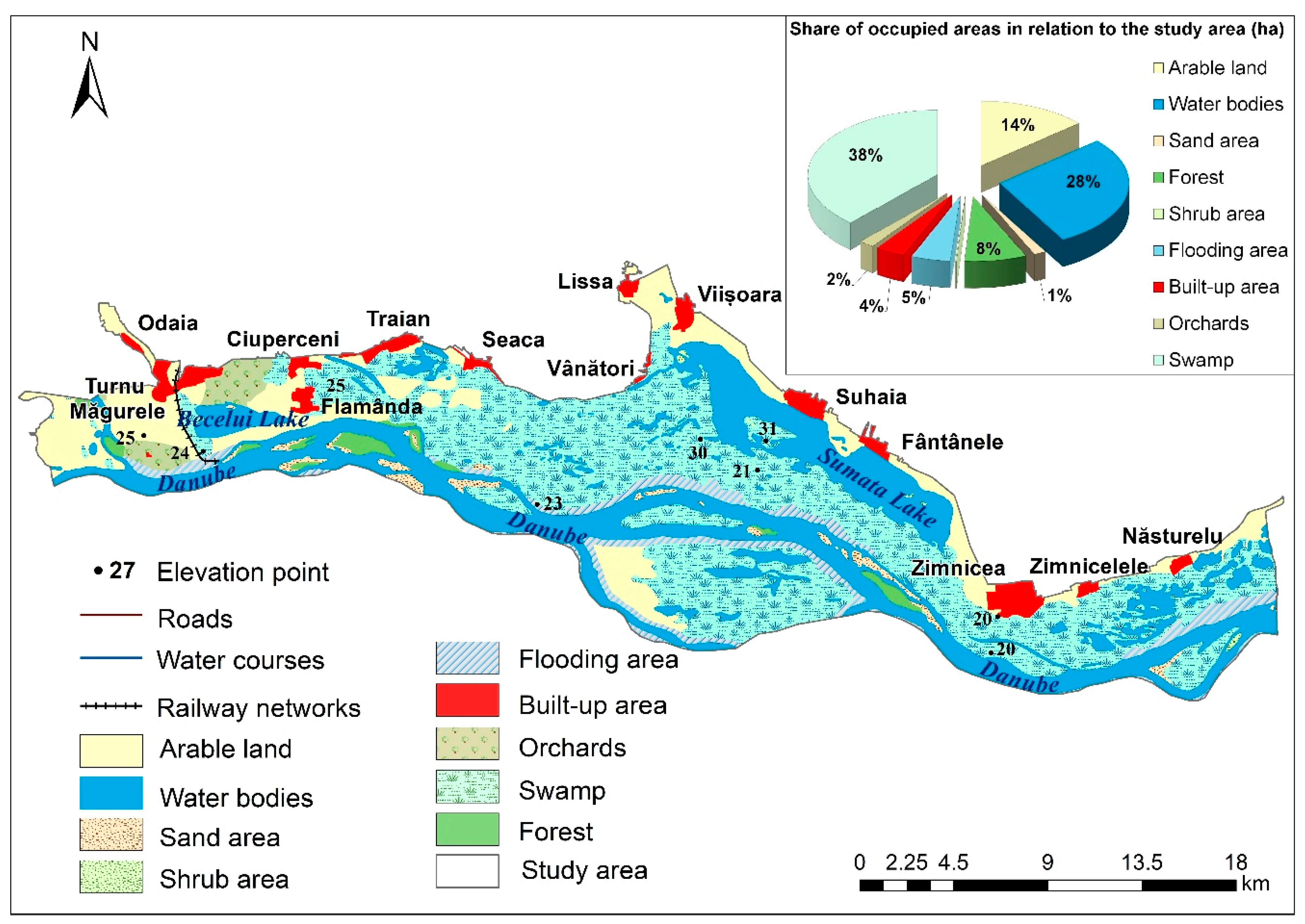
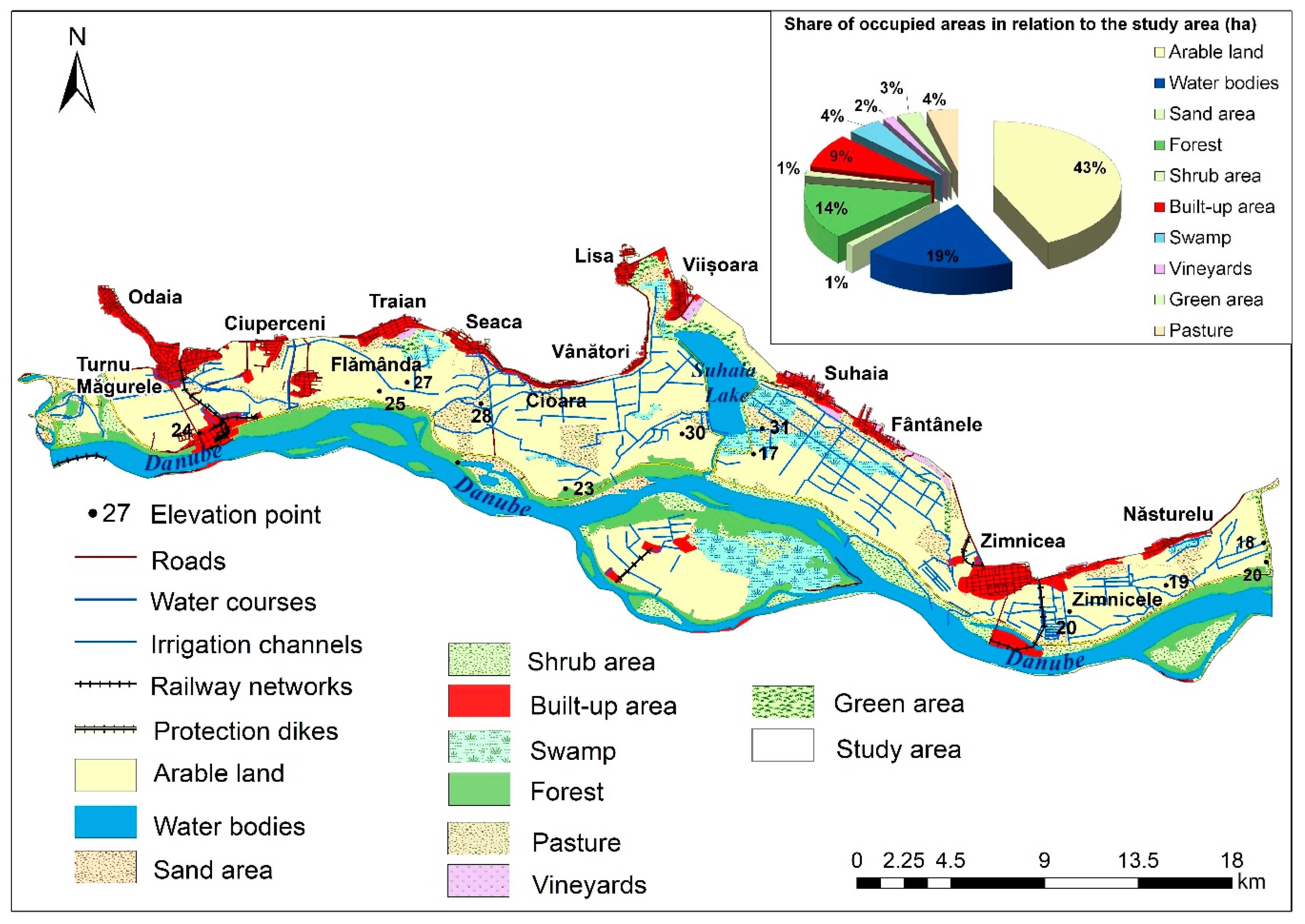

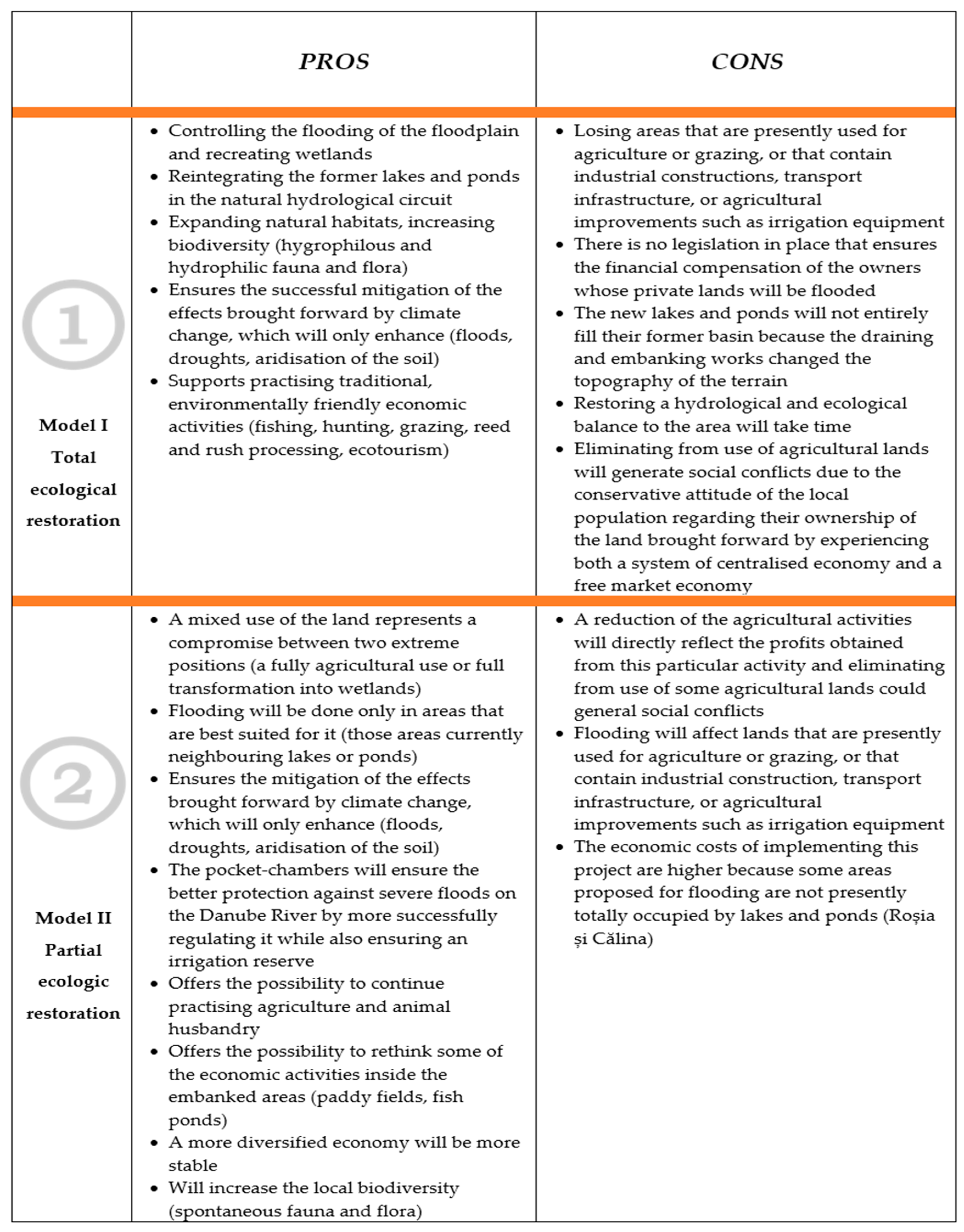
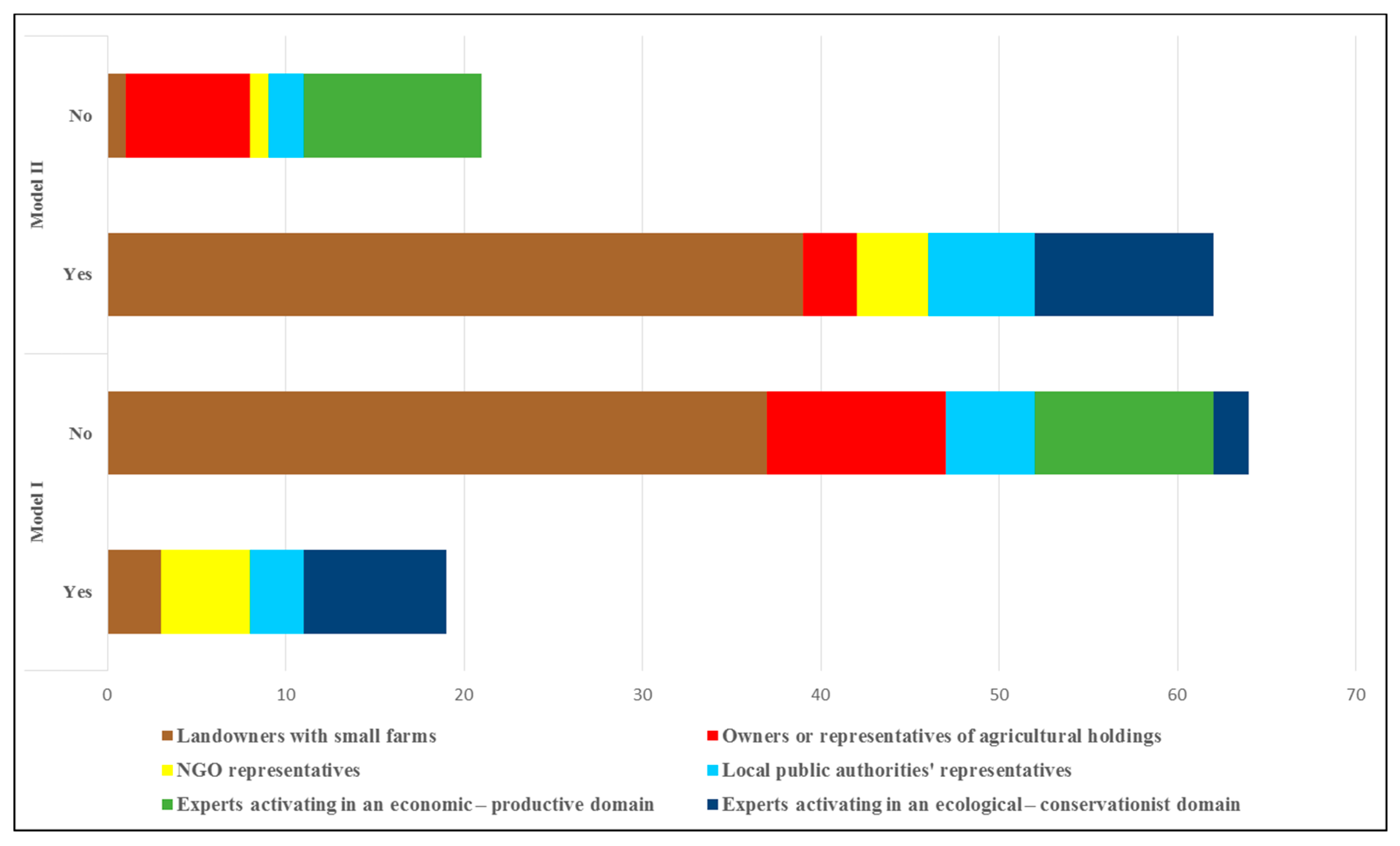

© 2019 by the authors. Licensee MDPI, Basel, Switzerland. This article is an open access article distributed under the terms and conditions of the Creative Commons Attribution (CC BY) license (http://creativecommons.org/licenses/by/4.0/).
Share and Cite
Vijulie, I.; Preda, M.; Lequeux-Dincă, A.I.; Cuculici, R.; Matei, E.; Mareci, A.; Manea, G.; Tudoricu, A. Economic Productivity vs. Ecological Protection in Danube Floodplain. Case Study: Danube’s Sector between Olt and Vedea. Sustainability 2019, 11, 6391. https://doi.org/10.3390/su11226391
Vijulie I, Preda M, Lequeux-Dincă AI, Cuculici R, Matei E, Mareci A, Manea G, Tudoricu A. Economic Productivity vs. Ecological Protection in Danube Floodplain. Case Study: Danube’s Sector between Olt and Vedea. Sustainability. 2019; 11(22):6391. https://doi.org/10.3390/su11226391
Chicago/Turabian StyleVijulie, Iuliana, Mihaela Preda, Ana Irina Lequeux-Dincă, Roxana Cuculici, Elena Matei, Alina Mareci, Gabriela Manea, and Anca Tudoricu. 2019. "Economic Productivity vs. Ecological Protection in Danube Floodplain. Case Study: Danube’s Sector between Olt and Vedea" Sustainability 11, no. 22: 6391. https://doi.org/10.3390/su11226391
APA StyleVijulie, I., Preda, M., Lequeux-Dincă, A. I., Cuculici, R., Matei, E., Mareci, A., Manea, G., & Tudoricu, A. (2019). Economic Productivity vs. Ecological Protection in Danube Floodplain. Case Study: Danube’s Sector between Olt and Vedea. Sustainability, 11(22), 6391. https://doi.org/10.3390/su11226391







